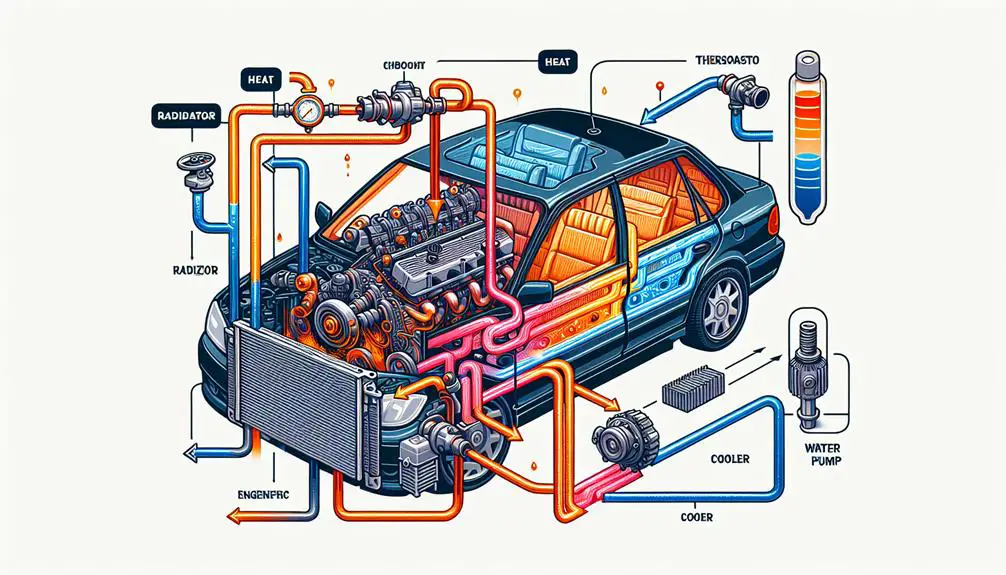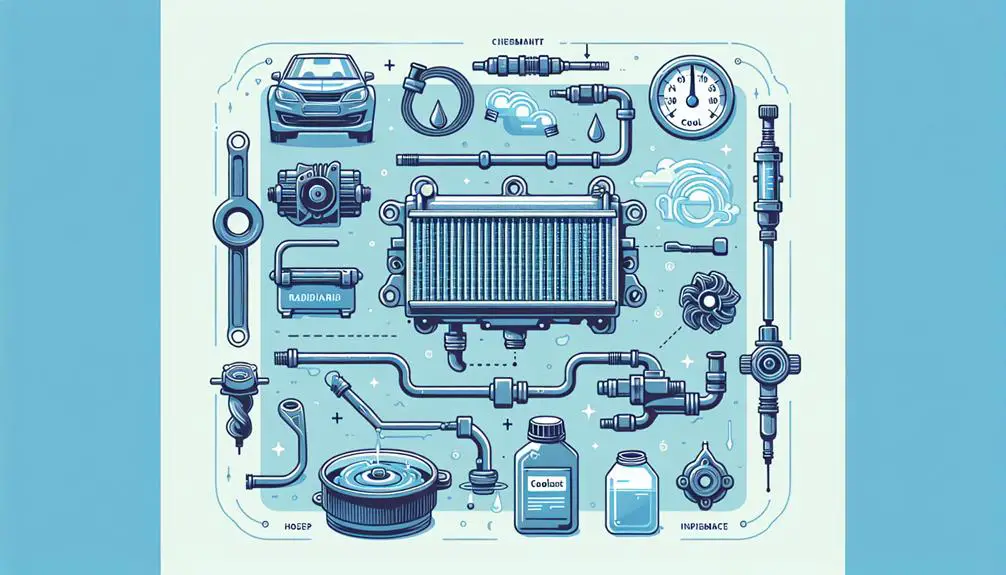A car's cooling system works by circulating coolant through the engine to absorb heat.
The heat is then transferred to the radiator to be cooled by air.
Finally, the cooled fluid is recirculated back through the engine.
The Role of Coolant

At the heart of your car's cooling system, coolant plays a critical role in regulating engine temperature by transferring heat away from the engine components to prevent overheating. This necessary fluid comes in several types, each designed to meet specific engine requirements and environmental conditions. Ethylene glycol and propylene glycol-based coolants are the most common, offering freeze protection and heat dissipation qualities. However, their chemical composition and performance characteristics vary, with some providing better corrosion protection or being more environmentally friendly.
You must handle coolant disposal with care essential its toxic nature. Improper disposal can lead to environmental contamination, harming wildlife and polluting water sources. It's vital to follow local regulations, which often involve taking used coolant to a designated recycling or disposal facility. This guarantees the hazardous substances within the coolant are dealt with responsibly, mitigating environmental impact.
Comprehending coolant types and the importance of proper disposal is crucial. It's not just about maintaining your vehicle's performance but also about safeguarding the environment. Regular checks and maintenance of your car's coolant system can help prevent engine damage and contribute to a greener planet.
Components of the System
Appreciating the significance of coolant and its disposal, it's now time to investigate the different components that make up your car's cooling system and how they function together to maintain engine temperature. Comprehending these elements is critical for identifying issues and ensuring peak performance.
Here are the key components:
- Radiator: Central to the cooling system, the radiator's design allows coolant to dissipate heat into the air, aided by a fan when necessary. Its efficiency hinges on the surface area and airflow, making its maintenance and design pivotal for engine cooling.
- Thermostat: Acting as a gatekeeper, the thermostat's function is to control coolant flow based on temperature. It remains closed to allow the engine to warm up quickly and opens to let coolant circulate through the radiator once operating temperature is reached.
- Water Pump: This component propels coolant throughout the system, ensuring continuous flow between the engine, radiator, and other components.
- Coolant Reservoir: A storage tank for excess coolant, it allows for expansion and contraction of coolant owing to temperature changes without causing damage or leaks in the system.
These components, each with a distinct role, work in harmony to prevent overheating and maintain peak engine performance.
The Cooling Process

To understand how your car stays cool under the hood, let's investigate the step-by-step process that governs the cooling system's operation. Initially, the engine generates heat as it runs. This heat must be managed to prevent overheating and make sure ideal performance. Here's where thermal regulation comes into play.
The cooling system kicks in, circulating coolant—a mixture of water and antifreeze—through the engine. The coolant absorbs the engine's heat, transforming it from a high temperature to a manageable level. Next, the heated coolant moves towards the radiator, the core site for heat dissipation. As the coolant flows through the radiator's thin tubes, outside air, improved by the fan, passes over and around these tubes. This airflow significantly reduces the coolant's temperature.
After shedding its heat, the now-cooled coolant moves back into the engine to absorb more heat, continuing this cycle. This process of heat absorption, transfer, and dissipation keeps the engine within its ideal operating temperature range. Additionally, the thermostat plays a critical role, regulating the flow of coolant based on the engine's temperature, making sure that the engine warms up quickly and maintains its temperature efficiently. This closed-loop system is vital for your car's thermal regulation, preventing overheating and ensuring smooth performance.
Common Cooling Issues
Comprehending the cooling system's operation sets the stage for recognizing when things go wrong, as different issues can disrupt this delicate balance. When you're aware of the common cooling issues, you're better equipped to prevent or address them before they escalate into more substantial problems. Here's a detailed look into some typical problems that might plague your car's cooling system:
- Leakages in the Cooling System: One of the primary overheating causes stems from leaks in hoses, the radiator, water pump, or gaskets. These leaks lead to a loss of coolant, impairing the system's ability to regulate engine temperature effectively.
- Radiator Problems: A clogged or damaged radiator restricts coolant flow, hampering heat dissipation. Debris accumulation or physical damage can compromise radiator efficiency, leading to overheating.
- Thermostat Failure: The thermostat controls coolant flow based on engine temperature. A malfunctioning thermostat mightn't open, preventing coolant from circulating through the engine and causing temperatures to spike.
- Fan Malfunctions: Cooling fans help in lowering the coolant temperature in the radiator. Electrical issues or a faulty fan motor can cause the fan to fail, significantly impacting the system's cooling capacity.
Comprehending these common issues allows you to take proactive steps in maintaining your car's cooling system, ensuring your engine runs smoothly and reliably.
Maintenance Tips

Regular maintenance of your car's cooling system is crucial for preventing overheating and extending engine life. This system, critical in managing your engine's temperature, demands a keen approach to upkeep. Let's explore the specifics, focusing on how certain maintenance tasks like oil changes and tire rotation play a role in the cooling system's efficiency.
To begin with, timely oil changes are more than just lubricating engine parts; they're about heat dissipation. Fresh oil efficiently transfers heat away from the engine components, indirectly supporting the cooling system's function. As oil ages, it loses its thermal conductivity, making your engine work harder and, as a result, heat up more. Adhering to the recommended oil change intervals isn't just good practice; it's a crucial step in maintaining your cooling system's integrity.
Likewise, tire rotation might seem unrelated at first glance but think again. Uneven tire wear affects your car's balance and, ultimately, its fuel efficiency. When your vehicle works harder to compensate for this imbalance, it generates additional heat, putting extra strain on your cooling system. By ensuring even tire wear through regular rotation, you're indirectly aiding in keeping your engine cool.
Conclusion
Essentially, you've seen how crucial the coolant is in dissipating heat from your engine, involving several key components. The cooling process, a delicate balance of heat exchange, relies on the efficiency of each part. Common issues, if neglected, can lead to significant engine damage.
Hence, adhering to regular maintenance tips isn't just advisable; it's crucial. Keeping your car's cooling system in top shape guarantees longevity and peak performance, reflecting the importance of comprehension and proactive care in automotive upkeep.
